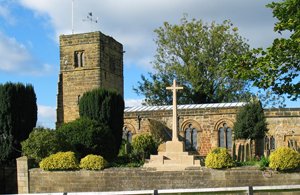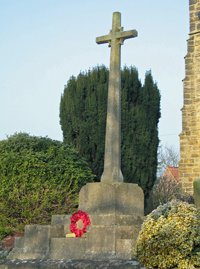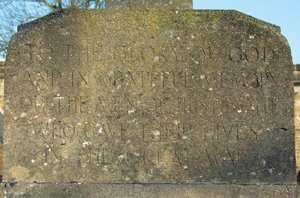Showcase result
Husthwaite
Town or City: York
County: North Yorkshire
Country: England
WMT Reference Number: WM2367
Value of grant: £1040.00
Type of memorial: Freestanding
Type of work: Conservation and repair
Grant scheme: Small Grants Scheme
Year: 2008
UKNIWM reference number: 29655
 The memorial in the north Yorkshire village of Husthwaite stands in the churchyard on the southern side of St. Nicholas’ church. It is carved from Clipsham stone and is in the form of a cross on a plinth and a three stepped base.
The memorial in the north Yorkshire village of Husthwaite stands in the churchyard on the southern side of St. Nicholas’ church. It is carved from Clipsham stone and is in the form of a cross on a plinth and a three stepped base.
In June 2008 War Memorials Trust made a grant of £1,040 towards work to clean the memorial, apply biocide, sharpen the letters where required, and to re-point the memorial using lime based mortar. Work was also undertaken to fix new plaques in the wall below the war memorial, upon which were engraved the original text from the memorial matching in size, font and layout the verses on the memorial.
 The memorial was built in 1920 with funds from public subscriptions and dedicated on 21st January 1921 by Cosmo Gordon Lang, Archbishop of York (who would go on to baptize Princess Elizabeth of York in 1926, and two years after that become Archbishop of Canterbury). During the War he had criticised some of the excesses of anti-German propaganda, recalling his "sacred memory" of the Kaiser kneeling beside Edward VII at the bed of Queen Victoria. As a result he became a target of public abuse. The memorial was designed by Messrs. Temple, Moore and Moore of London and built by Robert Thompson, sculptor of Kilburn, N. Yorkshire. The war memorial in Bishopthorpe (WM1921), another village in north Yorkshire, was also built by Robert Thompson and dedicated by Archbishop Lang.
The memorial was built in 1920 with funds from public subscriptions and dedicated on 21st January 1921 by Cosmo Gordon Lang, Archbishop of York (who would go on to baptize Princess Elizabeth of York in 1926, and two years after that become Archbishop of Canterbury). During the War he had criticised some of the excesses of anti-German propaganda, recalling his "sacred memory" of the Kaiser kneeling beside Edward VII at the bed of Queen Victoria. As a result he became a target of public abuse. The memorial was designed by Messrs. Temple, Moore and Moore of London and built by Robert Thompson, sculptor of Kilburn, N. Yorkshire. The war memorial in Bishopthorpe (WM1921), another village in north Yorkshire, was also built by Robert Thompson and dedicated by Archbishop Lang.
The inscription on the front of the plinth reads:
 "To the glory of God
"To the glory of God
and in grateful memory
of the men of Husthwaite
who gave their lives
in the Great War"
Below this on the front face of the steps are further inscriptions; “1914 – 1919” and on the lowest step “God guard his soldiers’ sleep”. On the two panels to the right and left of the inscriptions are carved the names of the fallen. On the face of the second step on the western side of the memorial is the inscription
“Forget us not O land for which we fell
May it go well with England still go well”
and on the second step of the western side
“Keep her bright banners without spot or stain
Lest we should dream that we have died in vain”
This verse has also now been inscribed into section of the stone wall round the churchyard which is in front of the memorial.
The first of the men commemorated on the memorial to fall was Pte. Cecil Stockdale of the Royal Marine Light Infantry, just three months into the war. His ship, the H.M.S. Good Hope left Portsmouth on 2 August 1914 for Halifax, Nova Scotia to patrol America's Atlantic seaboard as it was assumed German liners moored there would act as armed merchant cruisers. For the next few weeks HMS Good Hope was employed protecting British merchant shipping as far south as the Falkland Islands. She then embarked on the search for the German East Asiatic Squadron, leaving the Falkland Islands on 22 October for the west coast of South America via Cape Horn. HMS Good Hope was sunk along with HMS Monmouth by the German armoured cruisers Scharnhorst and Gneisenau under Admiral Graf Maximilian von Spee with the loss of her entire complement of 900 hands in the Battle of Coronel, on 1 November 1914, off the Chilean coast.
On the Western Front one of the battles that concurs well with the infamous reputation of Great War trench warfare was the Battle of Auber, a British action in the spring offensive of 1915. Most of the artillery was further north fighting in the Second Battle of Ypres so Field Marshal Haig did not get the artillery reinforcements he requested, and the battle was a disaster. The British troops went over the top early on the morning of 9 May and were cut down by German machine gun fire. The survivors were pinned down in No Man's Land. No significant progress was made, and early on 10 May Haig ended the offensive. The British suffered 11,000 casualties in one day of fighting on a narrow front. Pte. Percy Cartwright’s battalion took part in this battle, and he died on 25th May, so it seems likely he died of his wounds after the battle.
Two of the men commemorated on the memorial were brothers, sons of Rhodes and Louie Hebblethwaite, of Highthorne, Husthwaite. Abraham Rhodes Hebblethwaite was the elder of the two; he was a member of the 88th Battery of the Royal Field Artillery. He died in October 1915, probably of wounds sustained at the action of Pietre, a supporting action during the Battle of Loos. His brother Lieut. J.C. Hebblethwaite, who was a member of the regular army, also served in the Royal Field Artillery, in the 43rd Battery. He was a member of a howitzer brigade. Lieut. Hebblethwaite died in June 1916, eight months after his brother.
Company Sergeant Major Ernest Victor Batty was another member of the regular army, 1st Battalion King's Own (Royal Lancaster Regiment). His regiment landed at Boulogne 23 August 1914, two and a half weeks after the outbreak of the war, and he died during the last series of big offensives in the spring of 1918. It seems likely that he fell at the Battle of Bethune, an action during the Battle of the Lys, on 18 April 1918. The Battle of the Lys was the second of General Ludendorff’s offensives of 1918, designed to win the war before the ever-increasing number of American troops in France could enter the fighting. Both sides suffered heavy losses during the battle of the Lys, but Ludendorff failed to achieve his main target and the German army was sufficiently weakened to prepare the way for the Allied counter-attack. Company Sgt. Major Batty was the holder of the Distinguished Conduct Medal with a Bar and the Russian Order of St.George, awarded for acts of distinction under arms (although he served on the Western rather than the Eastern Front throughout the conflict).
The work undertaken by St Nicholas’ PCC, part funded by War Memorials Trust, has ensured that the memories of these men will be safeguarded for the future as we approach the centenary of their deaths.
Further information
War Memorials Trust reference WM2367
UK National Inventory of War Memorials: 29655
Cosmo Lang, Archbishop of York, who unveiled the memorial
Robert Thompson, who built the memorial
Picture of the Roll of Honour inside St Nicholas’ Church
The Battle of Coronel, 1 November 1914
The Battle of Aubers, 9 May 1915
If you have a concern about this memorial please contact the Trust on conservation@warmemorials.org


